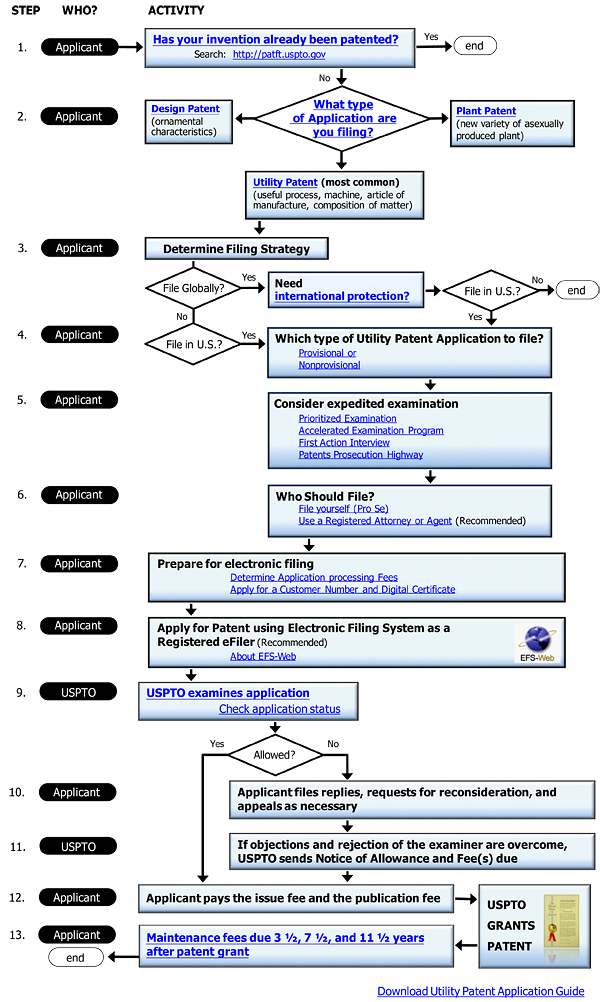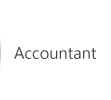
Introduction
There are three types of patents. Utility patents may be granted to anyone who invents or discovers any new and useful process, machine, article of manufacture, or composition of matter, or any new and useful improvement thereof. Design patents may be granted to anyone who invents a new, original, and ornamental design for an article of manufacture. Plant patents may be granted to anyone who invents or discovers and asexually reproduces any distinct and new variety of plant.
Requirements of Nonprovisional Patent Application
A non-provisional application for a patent is made to the Director of the United States Patent and Trademark Office and includes:
(1) A written document which comprises a specification (description and claims);
(2) Drawings (when necessary);
(3) An oath or declaration; and
(4) Filing, search, and examination fees. Applicant must determine that small entity status is appropriate before making an assertion of entitlement to small entity status and paying a small entity fee. Fees change each October. The fee schedule is posted on the USPTO Web site. Note that by filing electronically via EFS-Web, the filing fee for an applicant qualifying for small entity status is reduced by 50%. That’s a savings of almost $100 compared to the filing fee for a small entity applicant who files his or her application in paper.
Effective November 15, 2011, any regular nonprovisional utility application filed by mail or hand-delivery will require payment of an additional $400 fee called the “non-electronic filing fee”, which is reduced by 50% (to $200) for applicants that qualify for small entity status under 37 CFR 1.27(a). The only way to avoid having to pay the additional $400 non-electronic filing fee is by filing the regular nonprovisional utility application via EFS-Web. A small entity applicant who files electronically not only avoids the additional non-electronic filing fee ($200 for small entity applicants), the small entity applicant who files electronically also receives a 50% discount on the regular filing fee as discussed in the paragraph above. Effective November 15, 2011, the total savings to the small entity applicant who files electronically is almost $300!
Process for Obtaining a Utility Patent

Maintenance Fees
All utility patents which issue from applications filed on or after December 12, 1980 are subject to maintenance fees, which must be paid to maintain the patent in force.
Maintenance fees are due three times during the life of a patent, and may be paid without surcharge at:
- Three to three and a half years after the date of issue for the first payment;
- Seven to seven and a half years after the date of issue for the second payment; and
- 11 to 11 ½ years after the date of issue for the third and final payment.
Maintenance fees may be paid with a surcharge during the following "grace periods:"
- Three and a half years and through the day of the fourth anniversary of the grant of the patent;
- Seven and a half years and through the day of the eighth anniversary of the grant of the patent; and
- 11 ½ years and through the day of the 12th anniversary of the grant of the patent.
If the last day for paying a maintenance fee or any applicable surcharge falls on a Saturday, Sunday, or federal holiday, the fee may be paid on the succeeding day which is not a Saturday, Sunday, or federal holiday.
Patent Term
In the United States, under current patent law, the term of patent, provided that maitenance fees are paid on time, are:
- For applications filed on or after June 8, 1995, the patent term is 20 years from the filing date of the earliest U.S. application to which priority is claimed (excluding provisional applications).
- For applications filed before June 8, 1995 and for patents that were still in force on June 8, 1995, the patent term is either 17 years from the issue date or 20 years from the filing date of the earliest U.S. or international (PCT) application to which priority is claimed (excluding provisional applications), the longer term applying.












